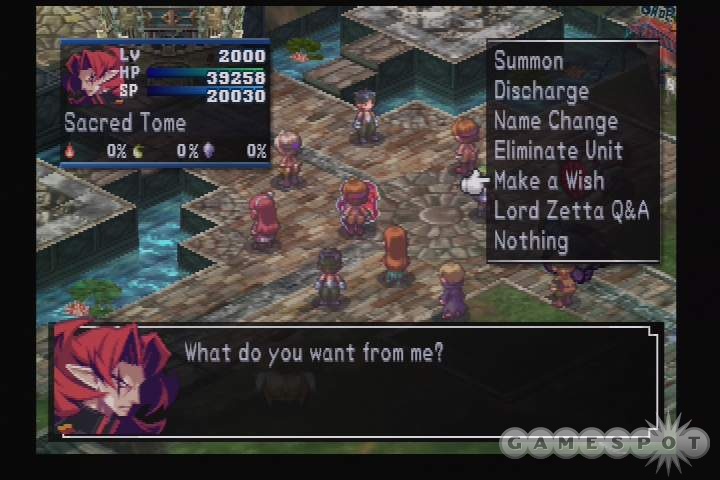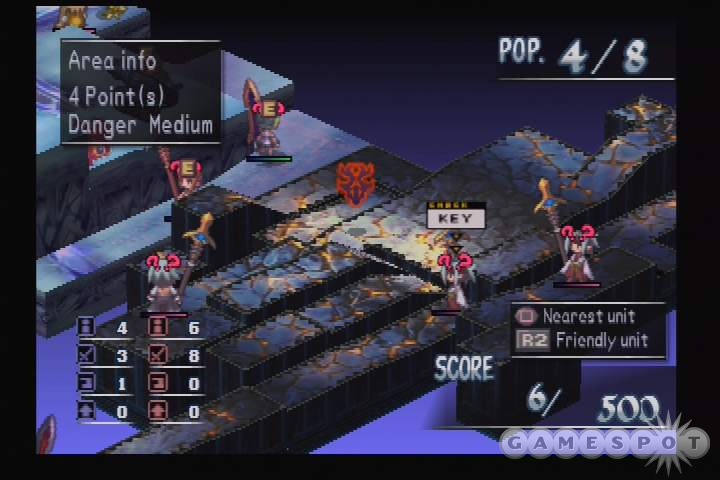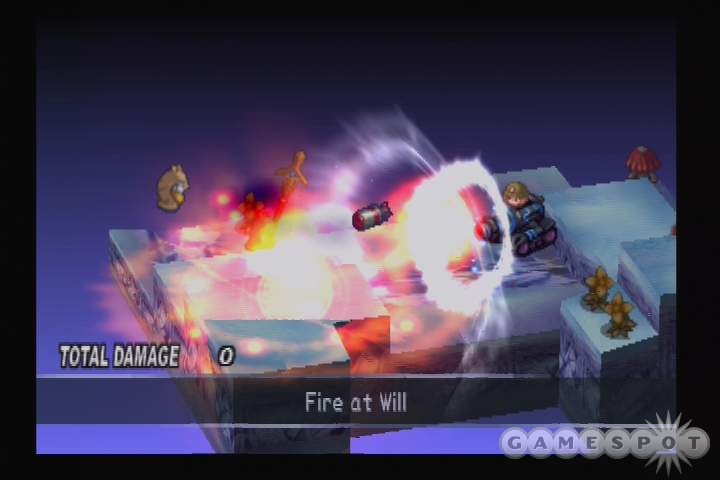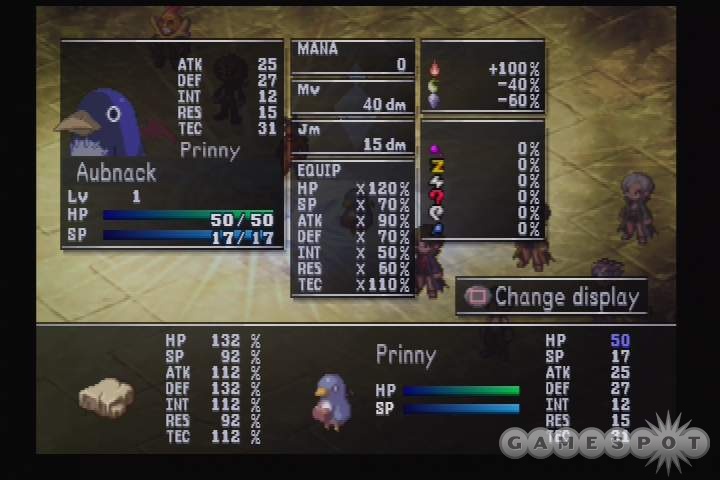You can almost count the number of strategy role-playing games for the PlayStation 2 on one hand--the US releases at least. In doing so, you'll notice that the majority of those games come from Nippon Ichi Software. When NIS released Disgaea: Hour of Darkness in 2003, it put a new spin on the genre with its quirky characters and its deep, complex game mechanics. However, it's been two years since Disgaea, and we've seen two other NIS strategy role-playing games released stateside. With each release, NIS isn't so much evolving the genre, as they are simply catering to a niche audience of metagamers who can look past or even appreciate the oddball mechanics and style of the games, while obsessively buffing its characters to hit the trademark 9999 level cap. The latest NIS release, Makai Kingdom: Chronicles of the Sacred Tome, is pretty much the same game as its predecessors, albeit with a few slight tweaks and a new (but not really new) story. But, even though it feels like worn territory, Makai Kingdom is still a charming and intelligent game with enough depth to sustain the gameplay long after the story is finished.

Makai Kingdom isn't a direct sequel, but it's the latest in a series of strategy role-playing games that began with La Pucelle: Tactics. In Makai Kingdom there are many parallel universes, and there are parallel netherworlds as well. Each netherworld has an overlord, and these overlords often fight among themselves in a never-ending power struggle. The main character is Lord Zetta, a self-proclaimed, "bad-ass freakin' overlord." Pram, another overlord and oracle that can see the future, prophesies the fall of Zetta's netherworld. Lord Zetta is the most powerful overlord in the cosmos, and he wants to keep it that way, so he sets out to find out how to prevent the fall of his netherworld by consulting the Sacred Tome, which is a magic book that holds all the secrets of the universe. When Lord Zetta opens up the book, he reads a message about how he doomed the netherworld with his own foolishness. When he reads that, Lord Zetta gets pissed and tries to burn the book. In the process, his entire netherworld goes up in a blaze and in a last-ditch effort to save himself, Zetta confines his soul in the Sacred Tome. Now in book form, Zetta is defenseless and alone without a netherworld to call his own, so several of his overlord friends show up to help him rebuild his netherworld and get his body back.
The story in Makai Kingdom is brief and not especially compelling. The characters aren't even playable in the game until you unlock them, which actually takes much more time and effort than it does to complete the story using a custom party of generic characters. Since Lord Zetta is a book and can't fight, you have to create a party of characters to do battle for him. This is accomplished by permanently confining souls to various objects. The character will get certain stat bonuses or penalties, depending on what the item is in which you have confined the character. This system is familiar to anyone who played Phantom Brave, except in this situation, when you confine a character it's permanent, unlike Phantom Brave where confined characters can only remain in play for so many turns. It's a good thing too, since the stages in Makai Kingdom can get quite large and often take a long time to clear.

The gameplay in Makai Kingdom revolves around turn-based battles that take place on a variety of randomly generated battlefields. When each battle begins you'll start with only Lord Zetta, and you'll need to invite members of your party to join you, at which point you can place them anywhere within a set range of Zetta. You can invite up to eight characters to each battle. The game is turn-based, and order isn't based on initiative, so you can move and act with any of your characters in any order. This plays a big part in the strategy of the game, as you can move in, attack an enemy, then move out of the way. Makai Kingdom features the same free movement as Phantom Brave, but thankfully here the artificial intelligence seems to be smart enough not to stumble off the map when trying to navigate tricky areas. However, since there's no grid to keep characters aligned, they'll often end up bunched together or stacked two or three high on top of one another. This can get confusing, since your characters tend to look the same, and when they're bunched together it's difficult to tell them apart. The free movement system is especially frustrating, since the levels still seem like they're designed for grid-based movement, with hard angles and raised squares of land rather than smooth slopes. The terrain does add to the challenge and the strategy of the game, but more so it gets in the way and results in unnecessarily awkward character placement. As in previous games, you can pick up and throw any objects or characters on the battlefield. It isn't as useful here though, since you can only pick up a character if neither of you are holding a weapon, which can be a pain if you have to unequip your character, toss him across a gap, and then reequip him.
For the most part, the mechanics of battle are the same as in previous NIS games, and veterans will feel right at home. However, as is the tradition, Nippon Ichi has thrown in a couple of odd tweaks to the system, this time in the form of facilities, vehicles, and hidden areas. The facilities and vehicles must be summoned and invited into battle just like the characters. You can place several characters in a facility, invite that facility to battle, and then deploy the characters from there. The characters that came from the facility will then get a bonus of some kind, as long as the building remains intact. For example, characters deployed from a command center will get a 40-percent boost to their defense during battle. If a facility is destroyed, the effect goes away, and all characters inside the building are killed. Enemies can also enter your facilities and attempt to take them over, and you can do the same to theirs. There are more than a dozen different kinds of facilities in the game, including fortresses, hospitals, factories, and shops.

In addition to facilities, vehicles add a new twist on battles in Makai Kingdom. Vehicles can be equipped with weapons, accessories, and characters, and then they can be invited into battle. When attacked, the vehicle takes damage before the pilot does, and when the vehicle is destroyed the pilot can continue fighting. You can also hop out of a vehicle in the middle of battle in case you want to change pilots or use skills that can't be used while in a vehicle. The vehicles range from floating demon heads to mechs and motorcycles, and if you spend some time modifying them, vehicles can become quite powerful.
The vehicles are especially handy because the battlefields in the game can get huge. On most battlefields, there are multiple hidden areas that appear when you destroy a clearly marked "key" object or enemy. When these new areas are revealed, sometimes a large-scale status effect will come into play. For example, when you open a new area you might end up paralyzing everyone on the battlefield, or halving their hit points. These secret areas also contain more enemies, facilities, and objects. It's a fun and interesting battle mechanic, since you never quite know what's waiting for you. However, sometimes the levels get so big that it takes several turns just to get within range of the one or two enemies at the far end of a map. Luckily, you don't necessarily have to open up all these secret areas to clear a map, although it's usually worth your while to do so. In Makai Kingdom, each battle requires you to accumulate a certain amount of battle points in order to win. These battle points are amassed by destroying various enemies and objects on the battlefield. Once you have enough points, you can quit the battle, or you can choose to continue fighting. If you continue fighting you'll earn more points, and depending on the number of points you have in excess of the battle requirement, you'll get bonuses like special items, experience, and money. These bonuses are well worth the effort, so you'll usually want to destroy everything you see.
The battles in Makai Kingdom are always extremely difficult or extremely easy. When you reach a difficult level in the story missions, you can choose to have a character make a wish to create a free dungeon, which is a randomly generated set of battles you can fight through to gain experience and level up. Going through one of these dungeons can net you tons of experience, which means when you return to story mode your characters will significantly overpower your enemies, to the point that you'll easily be able to kill several enemies in one blow (while they repeatedly attack you and cause zero damage). Grinding through countless randomly generated dungeons takes the challenge and strategy out of the battles and just rewards you for spending lots of time leveling up your characters.
The look and sound of Makai Kingdom are distinctly Nippon Ichi in origin. The 2D character sprites look childish and the weapons are completely exaggerated, but it's charming nonetheless. The battle animations are overblown and spectacular as well, and you'll have fun trying out new skills and attacks just to see them performed. The story sequences use the same 2D sprites, but they are surprisingly emotive.
Makai Kingdom reuses many of the same sound effects from previous NIS games. Yes, the prinnies still say "dood!" in their helium-pitched voices. All of the story sequences are fully voiced, and you can even choose to listen to the original Japanese voice track if you want. The English voices are well done, and it's worth listening to since the dialogue is often pretty funny. The music is quite varied, and while there isn't much that particularly stands out, most of the music is good enough to keep you from muting it.
This game doesn't deviate much from its predecessors, but it does feel slightly more refined than the games it borrows from. There are countless hours of gameplay to be had here, but there's nothing other than your own ambition to carry you from one battle to the next. So, if you like strategy role-playing games and don't mind a bit of silliness, Makai Kingdom is worth checking out.
